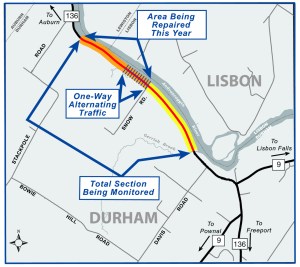DURHAM — Maine’s highway agency is expected to get more than $3.5 million in federal money to reimburse the state for moving a mile-long stretch of Route 136 that had been eroded by flooding in June.
The money was released from the Emergency Relief program within the Federal Highway Administration, according to Maine Congressman Mike Michaud, who serves on the House Transportation and Infrastructure Committee.
The section of new road runs from Snow Road in Durham northward to a bend in the Androscoggin River, which the roadway follows. The new roadway runs parallel to the old roadbed, which was being undermined by the river. After a storm in June, the Maine Department of Transportation installed a temporary traffic light, closing the lane closest to the river and converting the two-lane road to a single lane until September, when construction of the new road began.
Construction crews are completing that portion of the project, further stabilizing the riverbank. The new road will be resurfaced.
The total cost of the northern section of the Route 136 project was estimated at $4.7 million, including right-of-way purchases, survey and construction.
Later this year, the Maine Department of Transportation is expected to begin the second phase of the Route 136 project. As with the northern section, a new road will be built parallel inland from the existing roadbed for 1.25 miles from Snow Road southward.
The projected cost of that phase, including right of way purchases, survey and construction, is $5.56 million, said Scott Bickford, assistant highway program manager at the state agency. No federal money has been secured to help cover the cost of building a new parallel road alongside the southern section of Route 136.
Bickford said sandy soil along the Androscoggin River has contributed to the erosion of the existing roadbed.
Farther north, a shorter portion of Route 136 was moved inland after a failed effort to stabilize the riverbank with corrugated sheets of metal in 2010. A crane that was pounding the sheets into the roadside riverbank fell into the river when the roadway collapsed. The crane operator suffered minor injuries.
Michaud praised the announcement of the dedication of the federal money.
“This critical investment will help repair the embankment and road so that normal traffic flow can be restored,” he said.
The money is reserved for roads and highways on federal lands that have suffered “serious damage as a result of natural disasters or catastrophic failures from an external cause.”
The money is granted only after the president or governor has issued a formal emergency declaration and the state has filed a request for Emergency Relief for the cost of damage to its eligible highways. Eligible repair work includes emergency repairs needed to restore essential traffic, to minimize the extent of damage or to protect the remaining facilities, as well as permanent repairs necessary to restore the highway to its predisaster condition.

Comments are no longer available on this story